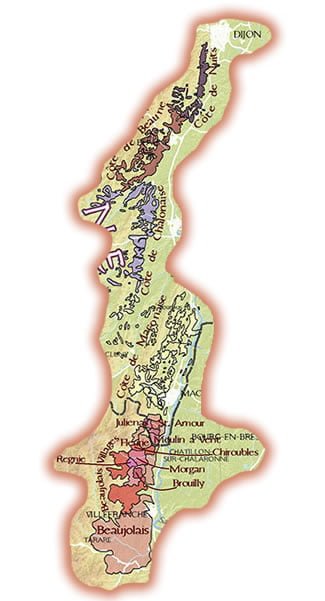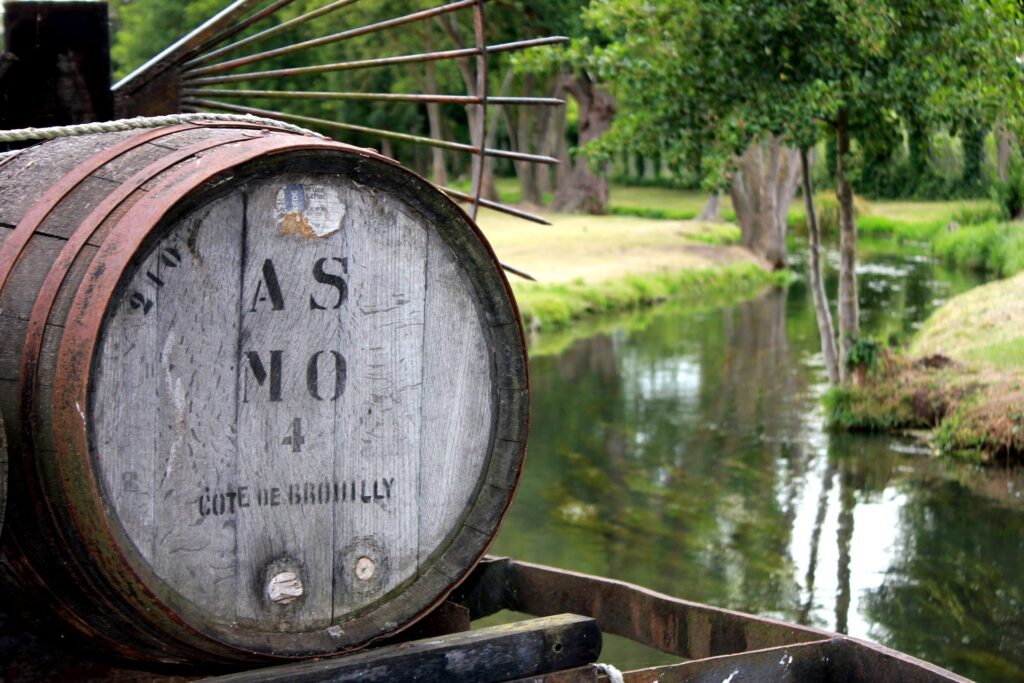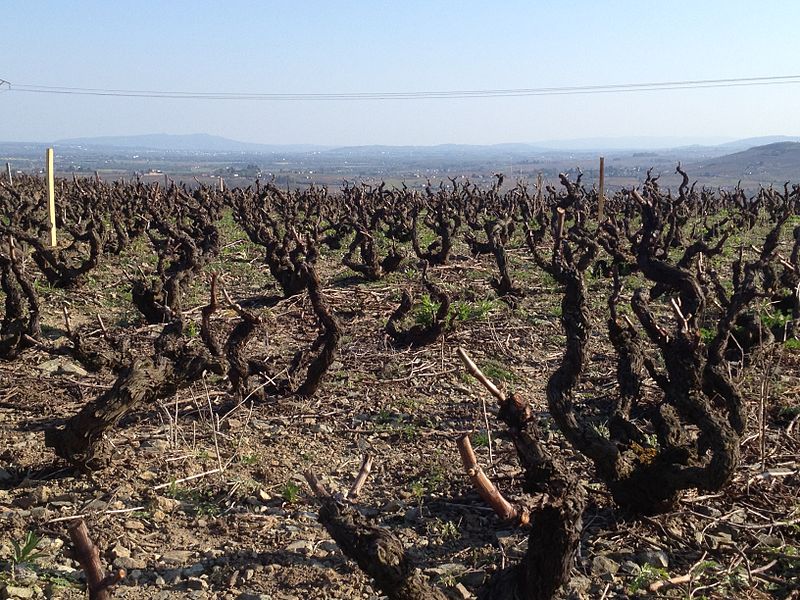Beaujolais is a convivial region of Burgundy with a refocused attention to style. It is a place where light-hearted wines and creativity are allowed to thrive.
Although nouveau is a popular and lively tradition, the region continues to prove it can produce much more than a harvest revelry and has worked diligently, innovatively, and eagerly engaged in legal disputes to protect its reputation.

Why This Region Matters
Celebrated winemakers and negociants produce quality vintages with a price tag unparalleled for the same level of quality in the rest of Burgundy. In addition, this region has a long history of independent thought and a collective passion for agricultural sustainability.
The Grapes
Although outlawed by the Dukes of Burgundy for a hundred years, Gamay Noir stubbornly remained the varietal of choice. Grown in soils of weathered schist, this hearty grape thrived in conditions unsuited for the more delicate Pinot Noir, favored in the rest of the region.
This thriving grape has become the overwhelming choice, with only Chardonnay (Beaujolais blanc) being produced otherwise and in tiny quantities. So Gamay found a home to produce more vigorous vines that contrived quality and cultivated unique expressions amongst each appellation.
Burgundy?
Although administratively and politically a part of Burgundy, Beaujolais has a decidedly different approach to wine and is generally set apart from the rest of the district. It is a compelling domain that simultaneously identifies itself as an independent entity while recognizing its Burgundian designation’s economic importance.

Regional History
The scenic vineyards along the Saone River have cultivated grapes since the days of ancient Rome. Still, arguably the beginning of modern winemaking here began in 1395 when Duke of Burgundy Phillippe the Bold outlawed Gamay Noir.
Pinot Noir
At that time, the French upper class believed that Pinot Noir was the superior varietal. The region’s reputation was put at risk by allowing the more prolific Gamay to grow in the area. As a result, the regulation remained unenforced in the more distant and independent Beaujolais, where farmers propagated the varietal.
Climate
The semi-continental climate with Mediterranean influences and granitic soils proved the winning combination for Gamay wine with supple fruit, refreshing acidity, and excellent structure. By the 15th Century, Gamay was once again legally permitted to cultivate.
Beaujolais Nouveau Wines
Most of the wine was consumed locally until the 19th Century, when railroads allowed Beaujolais’s popularity to spread.
During this time, the concept of Nouveau wines and the celebration it entailed came into play. These quick fermenting wines took a mere two months from harvest to bottle. The release turned from a national celebration into a worldwide frenzy under master businessman Georges Duboeuf.

End of an Era
Unfortunately, by the mid-1980s, the craze had faded. By the early 1990s, France was left with over 1.1 million cases of unwanted Nouveau to discard. In addition, it became difficult to sell any bottle of Beaujolais as the public associated the region with inexpensive, deficient wine that could not age.
With the sharp decline in demand, illegal chaptalization, and doctored wine scandals, the region’s plummeting prices left many vineyards bankrupt. However, with standout vintages such as ’05, 12′, and 14′ meaningful, the wines are once again beginning to resurface. Classifications
Three Categories
By law, the wines of Beaujolais is divided into three categories of quality, Beaujolais, Beaujolais-Villages Wine and Beaujolais Cru. The entire region has approximately 42,000 acres (17,000 hectares) under vine. To the west is the Monts de Beaujolais, and the Saone River valley borders the east.
Ten Crus of Beaujolais
The ten crus produce serious Gamay with gentle tannins, juicy and expressive fruit with a light to medium body that at times shows an intense minerality and charming notes of spice. Investors, new talent, and reinvigorated winemakers are beginning to remind the world what the region is capable of.
Crus Beaujolais Climate
The climate is continental with slight Mediterranean influences from the south. The summers are hot and dry, and the winters are cold. However, one region is geographically divided from north to south.
The northern (Haut) region contains desirable granite soils that house all of the Beaujolais Cru. The southern (Bas) region is flat and composed primarily of clay and sedimentary rock. The most basic versions (including Nouveau) are grown here.
In other regions of France, ‘cru’ indicates a particular vineyard, but here, ‘cru’ refers to the ten distinguished villages providing first-rate wines, all located on granite hills in the northern (Haut) region. The steep granite-based soils produce denser, richer, and more expressive Gamay with the ability to age.
AOC Villages
These wines will be labeled under their own AOCs, so it is worth becoming familiar with their names and styles to know what to buy. The ten crus are; Brouilly, Chenas, Chiroubles, Cote de Brouilly, Fleurie, Julienas, Morgon, Moulin-a-Vent, Regnie and St. Armour. Two crus that stand out, in particular, are Cote de Brouilly and Morgon.
Cote de Brouilly
The vineyards of Cote de Brouilly cover the slopes of the ancient dormant Mont Brouilly volcano located in the heart of the Beaujolais region and are surrounded by the much larger Brouilly appellation.
Although covering one of the smallest areas, just 751 acres (304 ha), the simultaneously meaty and elegant wines of Cote de Brouilly pack a big flavorful punch with an aging potential of four to six years. Brouilly is named for ancient Roman lieutenant Brulius, the first to plant vines over 2,000 years ago.

Mythology
According to local French mythology, the giant Garangtua has deepened the Saone river by removing rocks from the river bed and stacking them to form Mont Brouilly (there is also a version that describes him accidentally dropping the stones and not deliberating placing them there). The top of Mont Brouilly is considered an important spiritual place for growers from all parts of the region.
Notre Dame du Raisin
After devastating hail, mildew, frost, and the phylloxera epidemic, Notre Dame du Raisin was built to protect the vineyards from future disasters. On September 8th, the locals make an annual pilgrimage to the church to pray against crop damage. The alter is inscribed ‘A Marie protectrice du Beaujolais.’ The majority of the vineyards are located on the higher south end of Mont Brouilly and face east.
This location lends the protection of the vines from winds, places them on the steepest slopes, and gives the vines the advantage of early morning sunlight. The geographical fingerprint is distinguished by the presence of ancient volcanic activity, in particular, the blue freckled stone diorite. The soils are made up of diorite, granite, and schist with clay. This soil is so well-drained, which leads to the lack of water and nutrients optimal for growing vigorous vines that, while lessening the yield, produce Gamay grapes with a higher flavor concentration.
Grapes
Although appellation laws allow for a small percentage of Chardonnay, Aligote, and Melon de Bourgogne to be added to wines labeled Cote de Brouilly, Gamay dominates, making up 99% of all vineyards. Gamay from this region is regarded as the most intense of Beaujolais Rouge.
Tasting Notes
Cote de Brouilly can be described as bright crimson to deep purple with a medium to medium-plus body, lively iris, and fresh fruit aroma. A little cellaring adds to their elegance bringing forth more serious structure, minerality, and touches of spice. Standout producers include: Chateau Thivin, Domaine Jean-Claude Lapalu, Domaine de la Voute des Crozes, Domain des Terres Dorees and Potel Aviron.
Morgon
Situated on the south and southwest facing hills to the west of the Saone River is Morgon, the second-largest cru in the region at 2,745 acres (1,111 ha). The area comprises distinctive and vine challenging soil, including decomposing schist and granite with Paleolithic volcanic influence.

Terroir
Pockets of heavy clay, sandy loams, and rich iron oxide with traces of manganese deposits contribute to a remarkable depth and aging capability; it has been given its verbiage, “il Morganne.” The region is protected from the cold northern winds by the rolling hills to the west and benefits from the warm, arid winds of the east that aid in drying the soils after rain which helps protects the vines from various fungal diseases. Abundant sunshine moderated by the cooling Mediterranean influences develops the sugars and phenols while retaining acidity.
Tasting Notes
Morgon wine often features ripe fruit aromas, fleshy and rustic texture with spicy notes, and a firm mineral-laden backbone. Notable producers include Domaine de Terres Dorees, Chamonard, Domaine Marcel Lapierre, Georges Descombes, Jules Chauvet, Jean-Paul Thevenet and Guy Breton
Cote du Py
On the southern border of Morgon is the famous hill Cote du Py. This area is known to impart earthy complexity and robust structure that develops and softens with age, a feature reminiscent of the more celebrated regions of Burgundy. An exceptional assemblage of producers with a passion for old viticulture practices yields Gamay much denser than te other regions.

Winemaking Styles
Carbonic Maceration
Winemakers here use a style unique to the region, carbonic maceration or whole cluster fermentation. Whole bunches are placed into fermentation tanks where those on top crush the grapes on the bottom. The juices released start to ferment, and the sealed tank is filled with carbon dioxide. The CO2 permeates the fruit’s skin, starting the fermentation process inside the uncrushed berries.
This method produces wines with explosive fresh fruit, minimal tannins, and a lot of color. Beaujolais Nouveau winemakers add the cultured yeast 71B, sugars to pump up alcohol levels, and thermovinification to make vast quantities of cheap, artificial tasting wines for the popular November release. After the fall of Nouveau and the subsequent years of tormented sales and tarnished reputation,
Biodynamic Farming
Fabulous 2009 vintages nearly single-handedly rescued the region, specifically the legendary winemakers Lapierre, Thevenet, Foillard, and Brenton. These stalwarts of biodynamic farming faced the challenge of producing world-class wines and changing long-held dismissive opinions.
Chaptalization and filtration practices are discarded as well. As a result, winemakers in the region are ‘green’ in many ways, focusing on protecting ecosystems and actively contending with soil erosion.
Jules Chauvet
These winemakers set higher standards, starting with old vines, late harvesting, and meticulous sorting practices inspired by Jules Chauvet. The latter many consider the father of the natural winemaking movement in France. Chauvet, a gifted winemaker, taster, and chemist, dedicated his life to natural winemaking.
He contended that to make the best expression of wine, you must let nature take its course with little interference. Thus, synthetic herbicides and pesticides are never used, and there is little to no dosing of sulfur dioxide.
